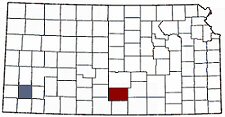Problems with the Ogallala Aquifer
ULYSSES - The prairie spreads for miles here in stubby, ashen-colored patches. Irrigation pivots spray out in circles, each minute sucking up hundreds of gallons of cold water from beneath the oil fields...
The vast underground pool that fills Ulysses' faucets, called the Ogallala Aquifer, is running low, forcing towns and farmers to spend beyond their means to tap alternative sources.
Quoted from: "As aquifer dries, 'water is like gold'" by Garance Burke. Associated Press, February 6, 2006.
 Map of Kansas courtesy of Wikipedia. The blue county is Grant County
Map of Kansas courtesy of Wikipedia. The blue county is Grant Countywhere Ulysses is the county seat. The red county is Kingman
County, where my brother and sister-in-law live.
This article is based on Ulysses, Kansas, a few counties west of where my brother and sister-in-law live. I talked to Kathy a few days ago, and she said it was very dry there. They hadn't been threatened by prairie fires in their immediate area, but they had smelled the smoke from fires in Oklahoma.
For the past couple of decades, southwest Kansas has been going through a significant dry spell. The chronic lack of rain makes farmers depend on irrigation -- and irrigation is a big drain on the Ogallala Aquifer. "Massive irrigation in western Kansas is depleting the Ogallala Aquifer from 5 percent to 7 percent every 25 years, according to a new report by the Kansas Geological Survey," writes Scott Rothschild in an article in the February 7, 2006, Lawrence Journal-World.
These articles don't say much about big cities that depend upon the aquifer, but they should be required to practice strict water conservation right along with the farmers.
When I was a child in the Nebraska Sandhills, we learned in school that water was easily accessible in the Sandhills because we had the Ogallala Aquifer beneath us. Our teacher told us that the Sandhills were like a big sponge that held water. Even though the land might appear arid, even desert-like, we could be sure that water was just beneath the surface.
Willa Cather wrote that in the Sandhills, the coyotes knew how to dig down to water. We children could have gone outside and dug down to water ourselves. Artesian wells were common in low areas of the valley where I grew up.
We ranch kids saw everyday evidence of the abundance of water in the windmill-powered wells that supplied water to the cattle. Water was one thing we had plenty of in the Sandhills. Rain might or might not come, but there was always water, and usually plenty of wind to pump it.
I am remembering the days before center-pivot irrigation systems were invented -- the days before corn was planted on many pieces of marginally-farmable land.
The depletion of the Ogallala Aquifer will have a great impact on the farm and ranch folks of the Great Plains. I have great affection and respect for those who still make their living from the prairie land. I fear that desertification will drive more of them off the land, and that the land will continue to pass from the hands of individuals to the hands of corporations.
Two related thoughts occur to me.
- Is there really any hope of bio-fuels becoming an oil substitute if we're in danger of running out of water in America's bread-basket?
- Doesn't the prospect of running out of water make it extremely important to develop drought-tolerant crops? I think genetic modification may become a necessity, not a choice.
No comments:
Post a Comment